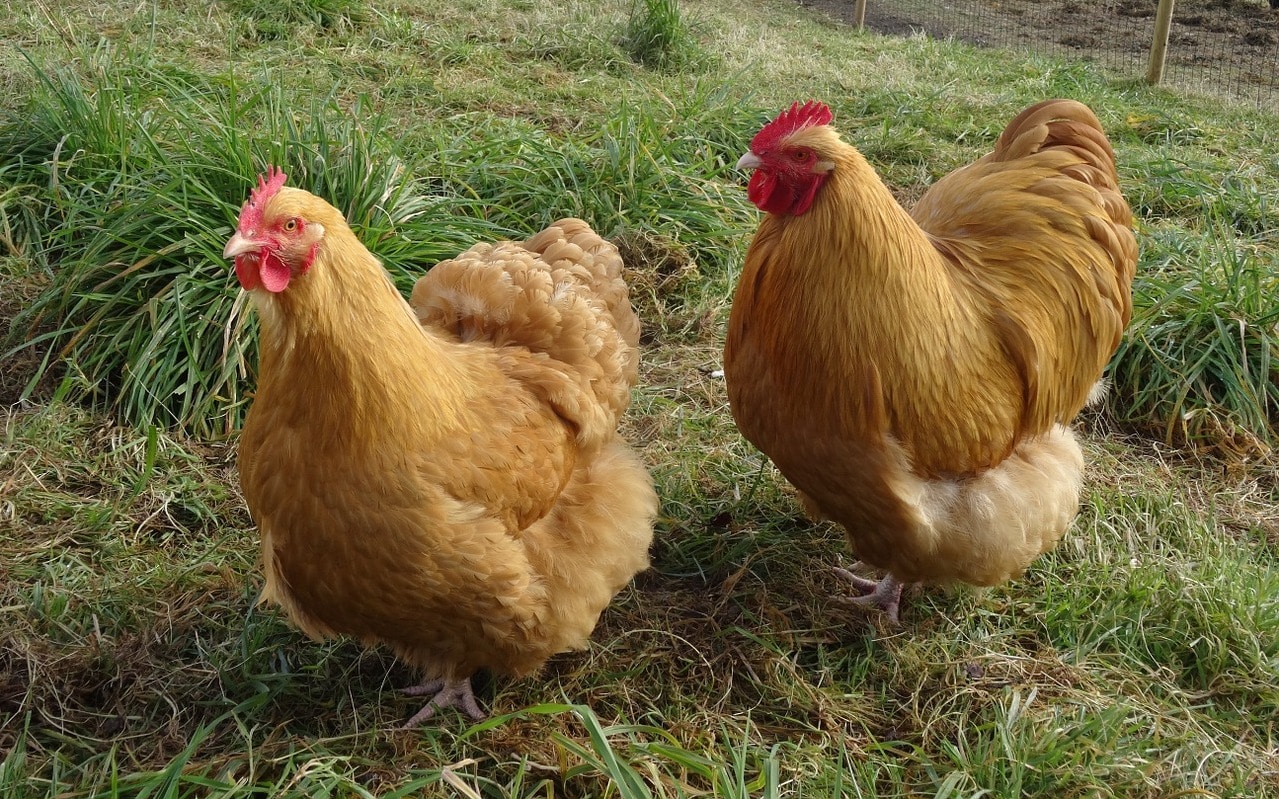Whether you live in the suburbs or deep in the country, you’ve likely considered raising chickens at some point in your life.
While other factors like egg production, temperament, and longevity might be important to you as you select a breed, noise should also be at the top of your priority list.
Docile & Quiet Chicken Breeds: Our Recommendations
Consider this list of the top fifteen quietest chicken breeds if you’re hoping for a tranquil experience in raising chickens – and aren’t interested in a constant cluck fest at all hours of the day!
1. Buff Orpingtons
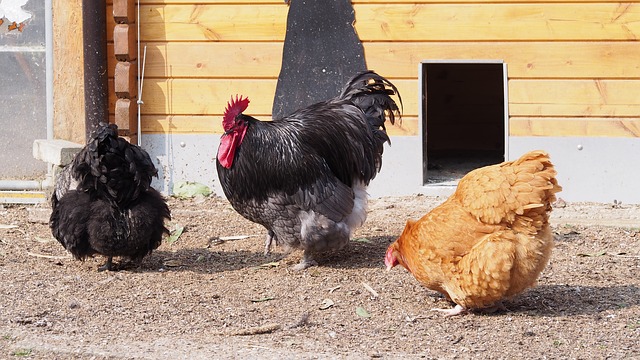
- Care Level: Easy
- Temperament: Outgoing
- Noise Level: Very quiet
- Purpose: Dual purpose (meat and eggs)
The Buff Orpington is a classic choice among backyard chicken keepers, and for good reason. This large breed, which has a warm golden color and an endearing personality, was developed in the United Kingdom in the late 1800s. There are countless varieties of Orpingtons, including Black, Blue, White, and, of course, Buff, all available. There isn’t much variation between these breeds – the naming system mostly just has to do with the color.
These birds have ridiculously soft feathers and are a great choice if you have small children or others who like to interact with the birds on a regular basis. They are extremely calm and won’t make a lot of noise. One of the few breeds that will allow you to pick them up, pet them (and, according to some chicken keepers, even train them), the Buff Orpington won’t make noise even when you approach it.
These chickens are not aggressive or anxious in the slightest, making them the perfect pick if you live in an urban or suburban area.
2. Ameraucanas
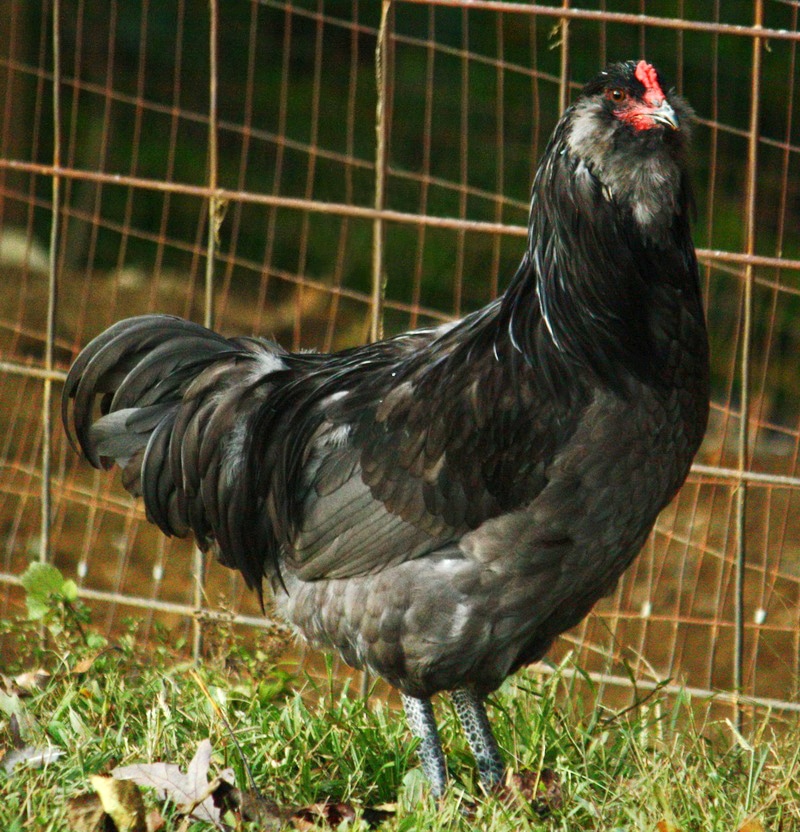
- Care Level: Moderate
- Temperament: Anxious and hesitant
- Noise Level: Moderately quiet
- Purpose: Eggs
Ameraucanas are odd-looking birds that are highly prized members of the showing and 4H scene. They are also fantastic layers, producing a bevy of medium-sized blue eggs. These chickens are large and can weigh up to seven pounds on average. Even hens of this breed frequently tip the scales at more than seven pounds!
You can find Ameraucanas in a variety of colors, and there have been several hybrid species of chickens bred directly from Ameraucanas mixed with other breeds as well. Popular Ameraucana colorations include brown red, silver, black, white, blue, buff, wheaten, and blue wheaten. Unlike other chickens who have ear tufts, this breed instead has a beard and muffs.
These chickens tend to be very calm and docile, but they will become cautious and even anxious if they feel they are under attack or threatened in any way. This can, of course, cause them to make more noise than they normally would. Providing proper predator protection and a nice enclosed coop and run can help them feel safer – thereby reducing the amount of noise they produce.
Luckily, it is very easily to handle Ameraucanas, and you don’t have to worry about them getting nervous if you pick them up – as long as they are used to you. The hens tend to be quieter and friendlier than the roosters, but these temperaments are, of course, subject to the environment in which you choose to raise them.
Providing your Ameraucanas with plenty of room to roam as well as “boredom busters” can help keep undesired behaviors (and noises!) at bay. Many people who raise Ameraucanas are more successful when they provide them with lots of space in a run. This will allow them to entertain themselves while pursuing bugs or other foods to eat, helping to reduce overall boredom.
3. Rhode Island Reds
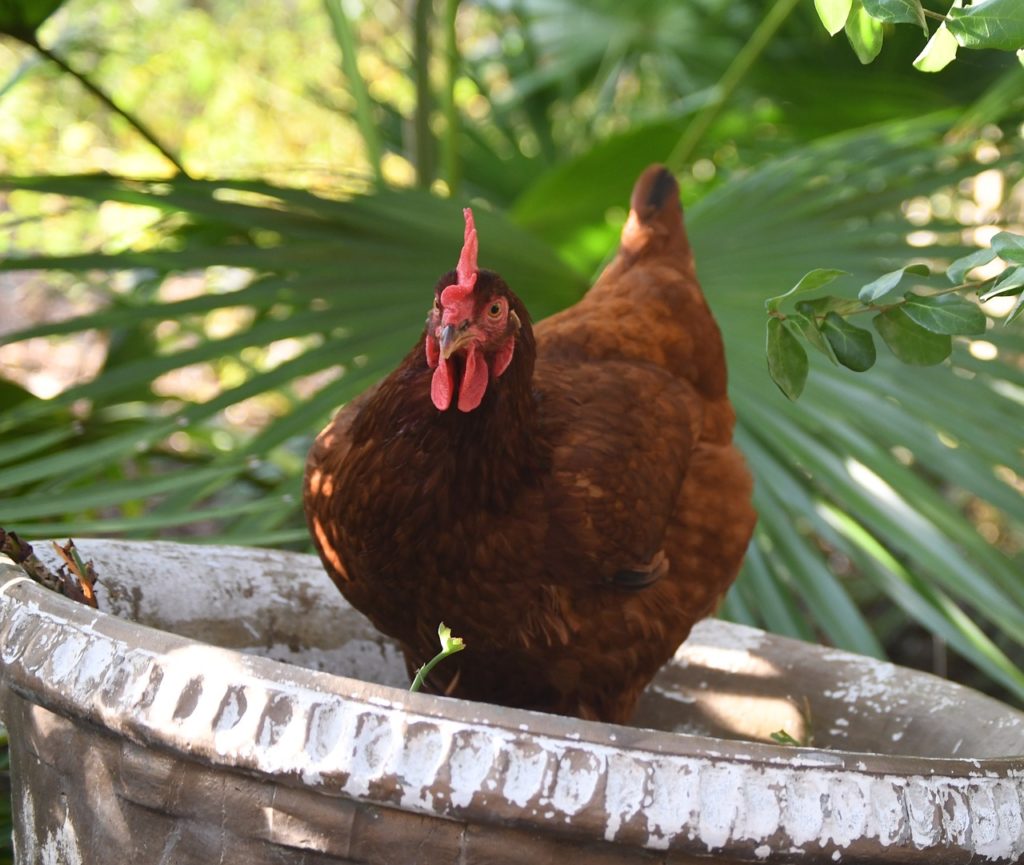
- Care Level: Easy
- Temperament: Docile
- Noise Level: Quiet
- Purpose: Dual purpose (meat and eggs)
Rhode Island Red chickens are exceptionally hardy dual-purpose birds that make very little noise. These chickens usually lay large brown eggs and while they aren’t exactly friendly (this is not the bird to get if you want to cuddle with your chickens), they don’t make a lot of noise and they are quite easy to train. They get along well with other breeds of chickens, as well as other poultry species like ducks and guineas.
Some people avoid raising Rhode Island Reds because they can be somewhat evasive, so if you’re looking for a pet chicken, this is not the one for you. However, they are extremely low-maintenance and produce delicious meat as well as eggs. Most modern strains have been bred for their egg-laying capabilities. Hens weigh around six pound (roosters are somewhat larger, if you’re interested in raising meat birds) and each hen will lay about two to three hundred eggs each year.
If you are looking for a bird that offers a compromise between good meat and egg production – without having to sacrifice your quiet time – this is the breed for you.
4. Speckled Sussex

- Care Level: Moderate
- Temperament: Calm
- Noise Level: Moderately quiet
- Purpose: Dual purpose (meat and eggs)
The Sussex is a breed of chicken that originated in England, but has gained great popularity in the rest of the world as well. A dual-purpose breed, the Sussex comes in a variety of colors, including lavender, buff, brown, light, silver, red, white, and, of course, speckled. As a result, this breed of chicken is one of the most popular as well as one of the calmest. You won’t hear a lot of noise from this gorgeous bird!
These birds are exceptionally mellow and docile, and will grow accustomed to your presence. Many backyard chicken keepers report that their Speckled Sussex chickens will follow them around the yard, hoping for treats! These chickens are talkative when they’re interested in food, but otherwise they tend to stay relatively quiet.
Speckled Sussex chickens are ideal for families, as they are friendly and very active. They will spend a lot of time foraging in your yard if you allow them to, but they can also handle confinement well, too.
Although these chickens are relatively cold hardy, they don’t hold up well in the heat. On hot days, you need to make sure you give your hens plenty of places to hide in the shade. A dual-purpose chicken, a Speckled Sussex hen will weigh about seven pounds and will lay roughly one egg every other day. These birds develop an even more impressive plumage from year to year, giving you something to look forward to as they guard themselves against predators.
5. Javas
- Care Level: Moderate
- Temperament: Shy
- Noise Level: Quiet
- Purpose: Dual purpose (meat and eggs)
The Java is a heritage breed that is recognized as the second-oldest breed of chicken – in the entire world! These chickens are dual-purpose, producing both meat and eggs, and the hens are very dependable layers. They won’t produce an endless supply of eggs, but they will lay enough to make it possible for you to sustain yourself and your family for sure.
These chickens are now endangered and were actually used in the creation of several more popular breeds of chickens, like Rhode Island Red sand Barred Rock Plymouths. These chickens are very quiet but are magnanimous in behavior, performing well when you keep them in smaller flocks.
6. Bantams
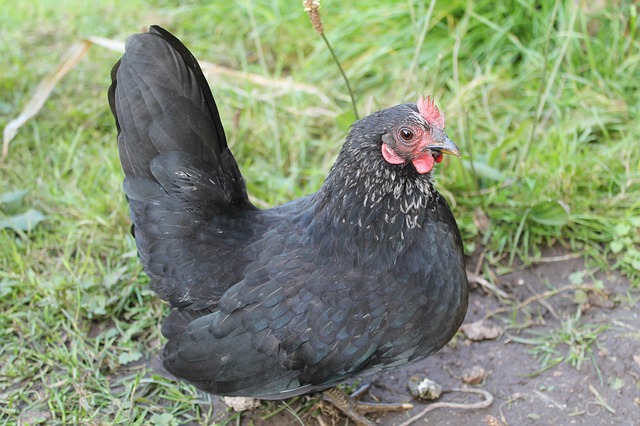
- Care Level: Moderate
- Temperament: Docile
- Noise Level: Quiet
- Purpose: Dual purpose (meat and eggs) and for exhibition
This is one of the few chicken breeds on this list that really offers it all. You can raise Bantams for meat (just keep in mind that they are one of the smallest chicken breeds), for eggs (which are about half the size of a regular-sized chicken egg), and for show purposes. In fact, the Bantam is one of the most popular show breeds.
What’s really special about Bantams is that they offer a gorgeous appearance along with highly desirable behaviors. For example, these chickens have excellent flocking and mothering instincts. You can keep a large number of Bantams in a small space, and even if you don’t have a rooster, Bantams are excellent sitters. They almost always become broody and can hatch their own eggs if you give them the time to do so.
Bantams come in an array of colors and although their eggs are small, they are produced in a dependable manner and are often quite delicious. If you decide to keep a mixed flock with several kinds of chickens, you should consider including at least a couple of Bantams, as they can serve as surrogate sitters for other chicken breeds like Rhode Island Reds, who rarely become broody.
7. Australorps
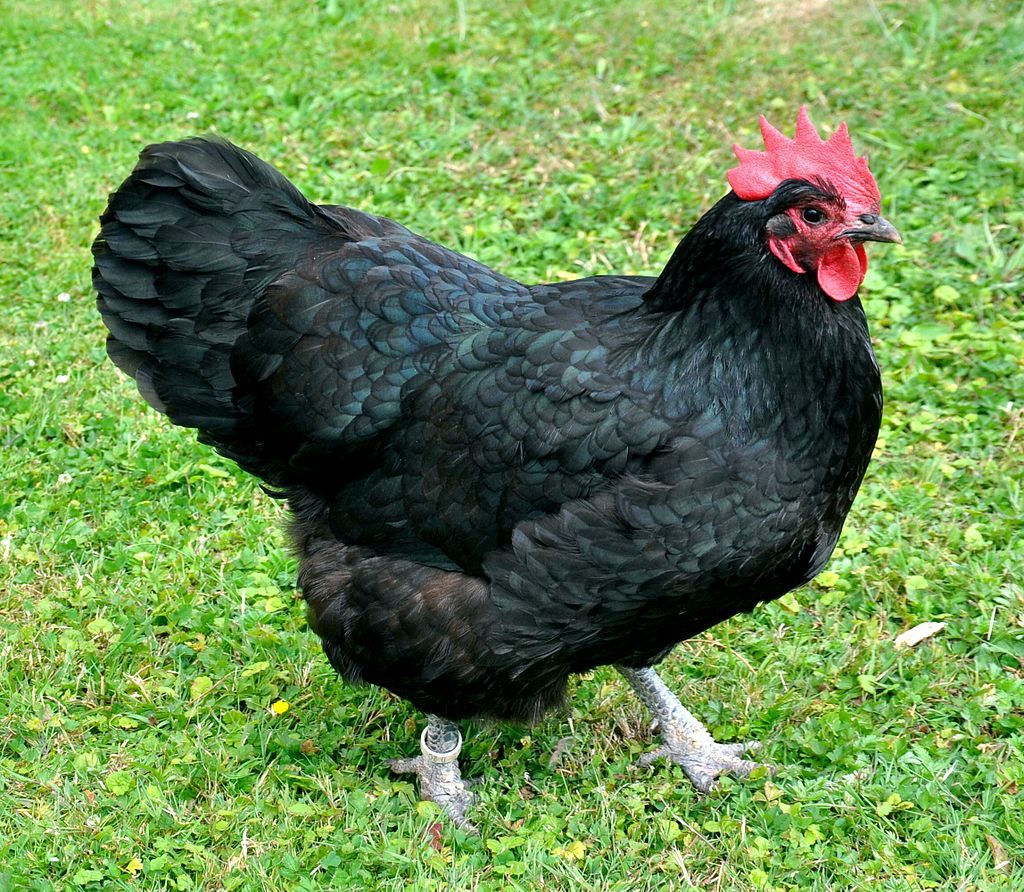
- Care Level: Easy
- Temperament: Friendly
- Noise Level: Moderately quiet
- Purpose: Dual purpose (meat and eggs)
The Australorp has often been referred to as “Australia’s version of the Orpington.” This chicken comes in a range of gorgeous colors, but the most common option is in black. Other varieties tend to cost more, and while these birds don’t have the fancy feathering of Orpingtons, they display a stunning iridescent quality in direct sunlight.
What’s more important is that these birds are extremely friendly. They are sweet and docile, often becoming family pets as they enjoy being held and being engaged with. Australorps love human company, and they also enjoy foraging in the yard. If you are raising chickens in a suburban or urban backyard, take comfort in the fact that most Australorps can thrive in confinement, too.
Australorps were originally raised as dual purpose breeds, so hens are relatively large – weighing in at around seven pounds. These birds are also good layers, producing about five light brown eggs a week (or 250 in a year). Australorps occasionally go broody, but not as often as some of the other chickens we’ve mentioned on this list. That being said, they can sometimes raise several clutches in just a year. They are both cold and heat tolerant, facing few fluctuations in their laying when enduring these weather swings.
8. Wyandottes

- Care Level: Moderate
- Temperament: Affable
- Noise Level: Quiet
- Purpose: Dual purpose (meat and eggs)
The Wyandotte is a great backyard chicken breed. This species is one of the most common among suburban backyard chicken owners, offering a friendly disposition and a dependable pattern of laying. These chickens are hardy, getting along well in times of both cold and exceptionally hot weather.
Many people prefer raising Wyandottes because they come in a wide variety of colors. You can purchase Wyandotte chickens in silver, blue, or even gold shades. There are even white Wyandottes, and while these are rare and tend to fetch a rather expensive price, they are a unique addition to any backyard flock. They will lay large, tan eggs, and can also be bred for meat purposes.
If you live in the suburbs, or even in the city, the Wyandotte breed is a good choice for you. This bird is both quiet and productive, and with vibrant coloring and striking plumage, you probably won’t have to worry about your neighbors complaining about your backyard flock. These birds are also popular among people who are interested in raising birds for 4H or other competitive showing purposes. As good layers, producing a heavy supply of eggs even during the winter months, these chickens are ones you have to consider if you are looking for a productive (yet quiet) breed.
9. Delawares

- Care Level: Moderate
- Temperament: Curious
- Noise Level: Moderately quiet
- Purpose: Dual-purpose (meat and eggs)
These meat breeds were once valued for their dual-purpose uses, but many chicken keepers now argue that the Delaware produces better meat than they do eggs. That being said, you can definitely raise a Delaware chicken as a dual-purpose breed i f you so choose!
These birds are highly inquisitive, and can be somewhat noisy at times. Luckily, they don’t produce a lot of noise as they are poking around your lawn. Delaware chickens have distinguishing black marks on their wings, tails, and necks. They are a lovely breed for urban chicken keeping as they produce both meat and eggs, and provide vibrant personalities to match their gorgeous appearance.
10. Easter Eggers
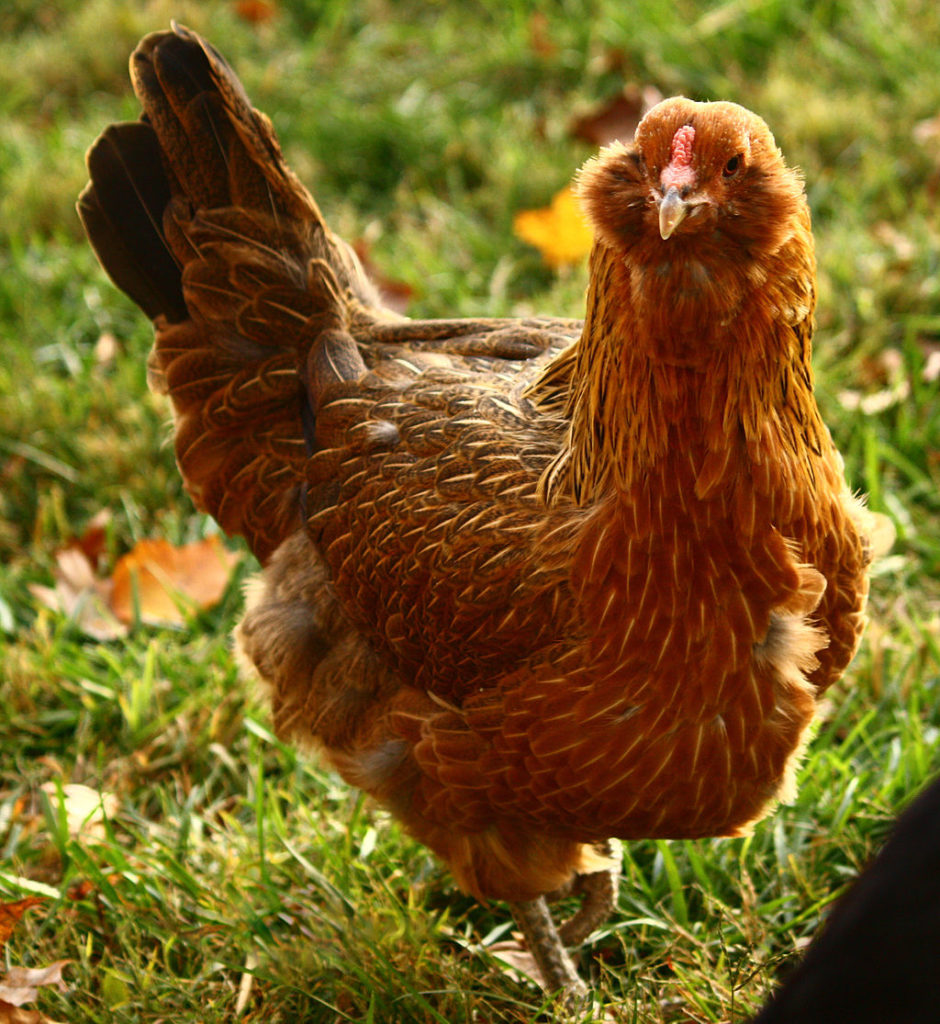
- Care Level: Moderate
- Temperament: Friendly
- Noise Level: Moderately quiet
- Purpose: Eggs
We know – the Easter Egger isn’t technically a chicken breed but instead a hybrid created from breeding Araucanas and Ameraucanas. These birds produce a certain variety of egg colors, which is usually what makes them a top choice for backyard chicken keepers.
These birds are also favored for their calm, friendly personalities. They are well-behaved around children, even docile and sweet in most conditions. They are winter hardy in most climates and can also tolerate heat. They prefer to forage, but can also thrive in a coop. You shouldn’t raise Easter Eggers if you’re looking for heavy meat birds, as they will only grow to about six pounds, but they will produce prolific quantities of brightly colored eggs. Usually, a single Easter Egger will lay up to four eggs each week.
11. Faverolles
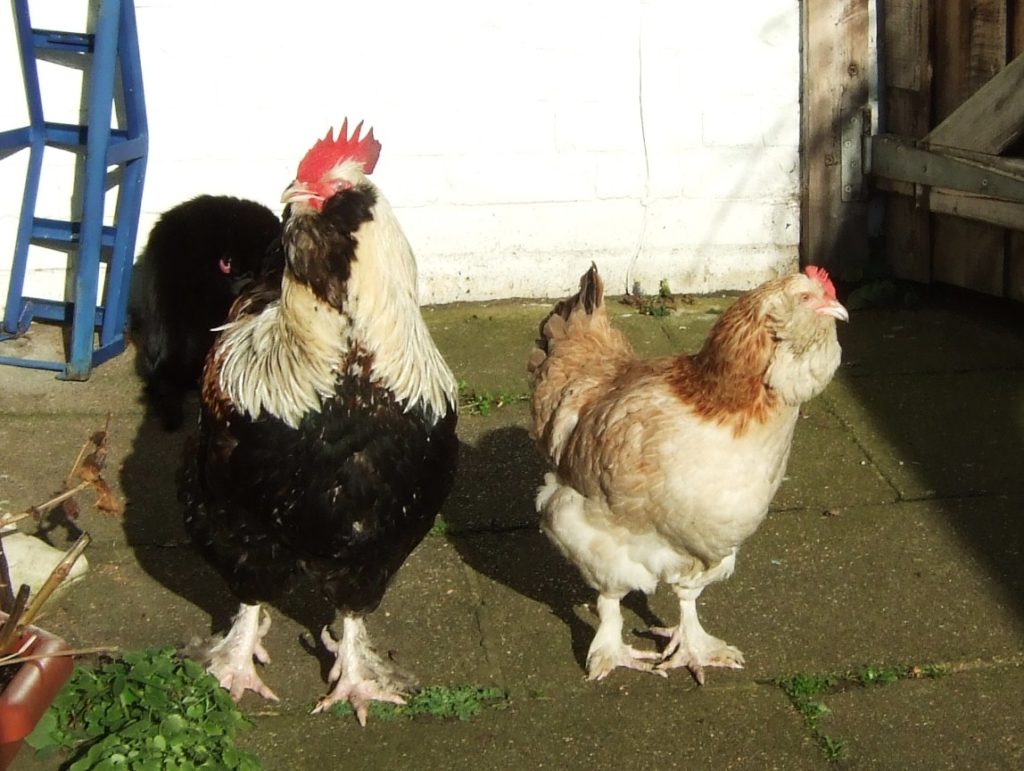
- Care Level: Easy
- Temperament: Gentle
- Noise Level: Moderately quiet
- Purpose: Dual-purpose (meat and eggs) and exhibition
Another dual-purpose breed, the Faverolle is also prized for its unique appearance. This bird has a fluffy beard and muffs, as well as fluffy-looking feathered legs. These chickens normally come in an unusual salmon color but can also be found in black and gold shades. They have five toes instead of four, which only adds to their shocking appearance. The Faverolle is a great choice for exhibition for this very reason.
Faverolles are very quiet and exceedingly gentle. You don’t have to worry about them bullying your other chickens or causing problems in the coop. They are quiet and although they aren’t exactly outgoing, they aren’t unfriendly, either.
12. Barred Rock Plymouths
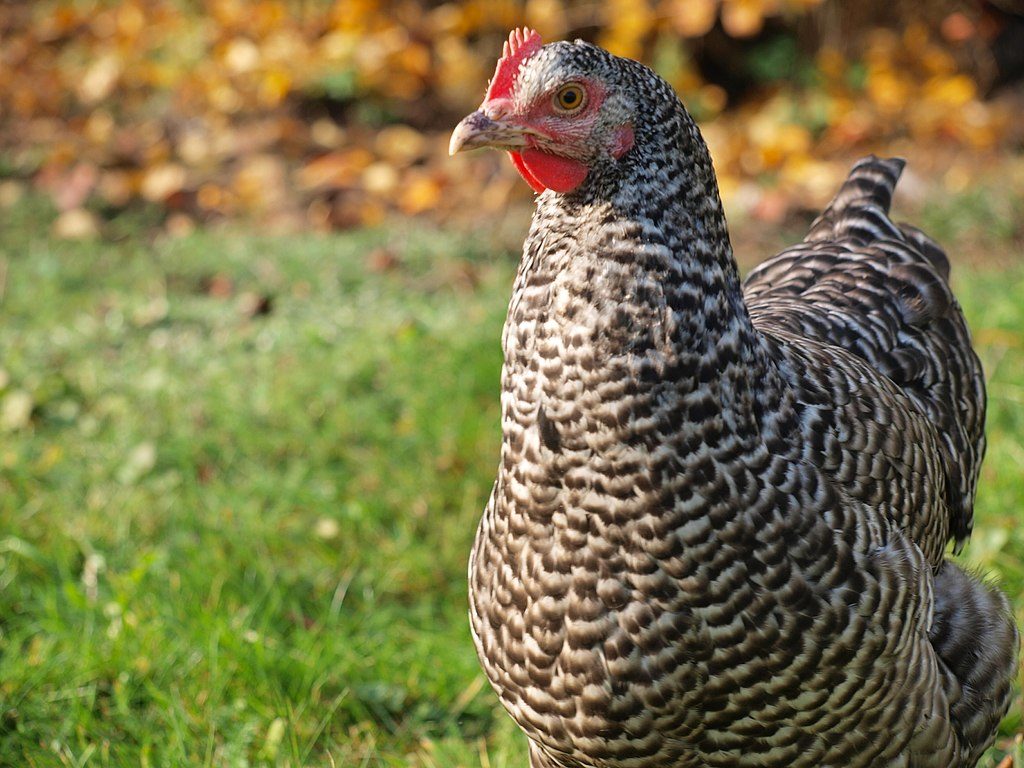
- Care Level: Easy
- Temperament: Outgoing
- Noise Level: Moderately quiet
- Purpose: Eggs
Barred Rock Plymouths are usually raised for egg production, but raising them for meat is not unheard of, either. These chickens have a unique appearance, with multi colored plumage in shades of white, brown, and reddish brown. They are relatively quiet but favored among many backyard chicken keepers because they are very friendly and get along with their caretakers (including children, if you have them).
One of the most common reasons that people choose to raise Barred Rock Plymouths is that they are readily available at most feed stores and hatcheries – you can find them just about anywhere. This is because they lay such large, delicious eggs, but it’s also because they are one of the only breeds of chickens that are sexable at hatching.
You can tell the difference between male and female Barred Rocks because the males each have a single white dot atop their heads. This can play a huge role in the noise level of your flock – remember, rooster tend to be the noisiest!
These chickens aren’t a great choice if you live in a warmer climate, but they hold up exceptionally well to the cold and snow. They will continue to lay eggs throughout the winter months, producing a steady supply of large brown eggs. They can tolerate coop or confinement housing, and are ideal for farmers who live on a small parcel of acreage. Therefore, this breed may be one of your best bets if you live in a town or city.
13. Cochins

- Care Level: Moderate
- Temperament: Caring
- Noise Level: Quiet
- Purpose: Exhibition
Cochins are typically raised for exhibition, and are available in a range of colors including bluish black, black, and light brown. These birds are round and fluffy and have feathers on their legs. They are fantastic mothers and will hatch the eggs of other chickens, as well as their own.
This large bird is considered a heritage breed, and was once kept as a pet by the Queen of England. They are average layers, but what they lack in laying ability they can make up for in their ability to serve as surrogate mothers for the eggs of other hens. Plus, they look pretty cool marching around your lawn!
14. Dominiques
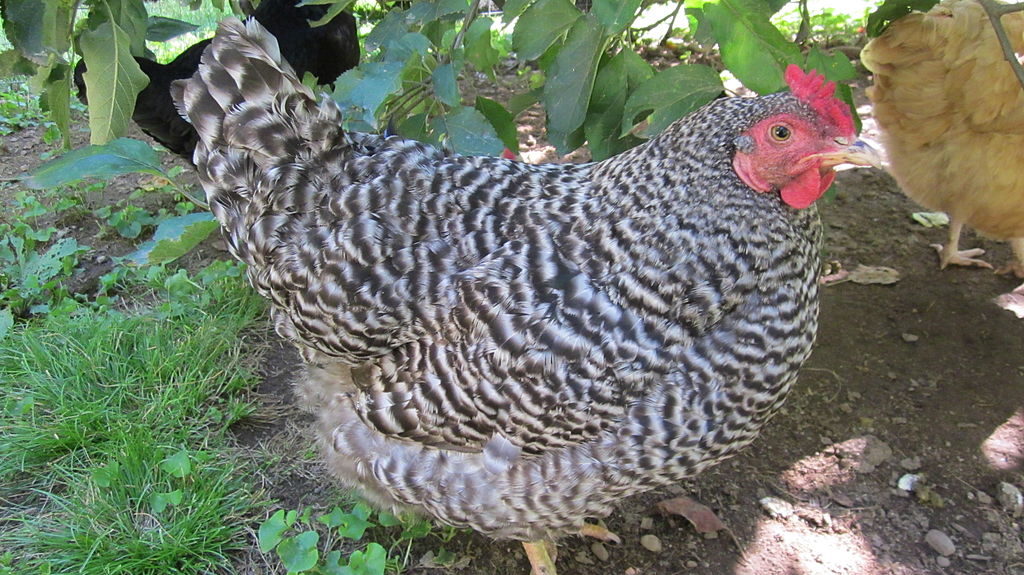
- Care Level: Easy
- Temperament: Calm
- Noise Level: Moderately quiet
- Purpose: Eggs
Now here’s a chicken you’ve likely never heard about! The Dominique is an older breed that is, unfortunately, on the watch status list with the American Livestock Breed Conservancy. It’s making a comeback from the verge of extinction, which is great news because this small breed was America’s first chicken breed.
Dominiques are excellent foragers that tolerate confinement quite well. They are unobtrusive and undemanding – and also very soft-spoken. These medium-sized birds have barred plumage with rosy combs. They are cold hardy and can also tolerate heat and humidity better than many other heritage birds. Though relatively small, they will lay up to 275 pale brown eggs each year.
15. Brahmas
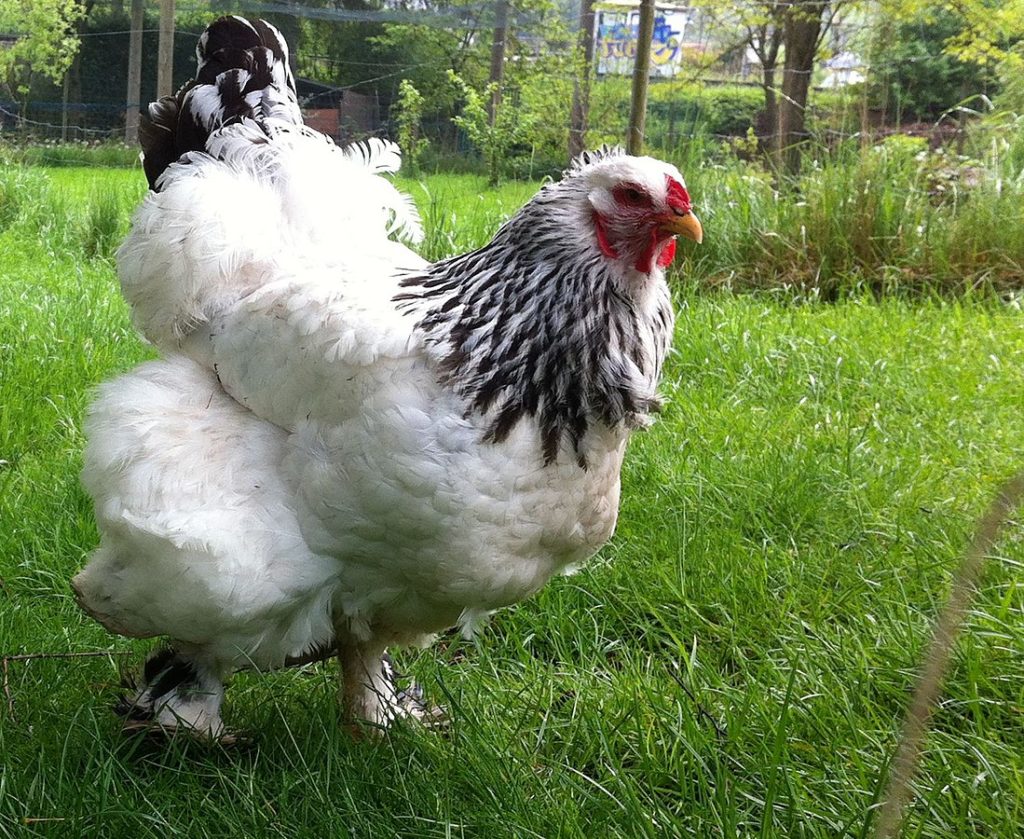
- Care Level: Moderate
- Temperament: Calm
- Noise Level:
- Purpose: Meat
Brahmas are large chickens, weighing up to eighteen pounds for a rooster and fourteen for a hen!
Therefore, they are frequently referred to as the “Kings of Poultry.”
These gorgeous, stately birds are incredibly calm and noble, going about their business in a discreet fashion.
They come in a number of varieties, including partridge, light, buff, and dark. Despite the differences in color, you’ll find that all Brahmas are exceptionally quiet.
While Brahmas are mostly raised for meat, you could also raise Brahmas for eggs, too.
These chickens lay snow-white eggs and are considered to be some of the best winter layers. In fact, some of their best laying happens between October and May.
Unfortunately, although Brahmas are great layers, their chicks often get trampled during the first few weeks of life because their mothers are so large.
Roosters vs. Hens
Keep in mind that regardless of breed, the biggest factor that will affect the noisiness of a chicken is its breed and gender. Roosters tend to make the most noise – and that’s no exaggeration. There are many benefits behind owning a noisy rooster, such as his ability to alert the flock to danger (or his ability to serve as your own personal alarm clock!) but if you are looking to cut down on noise pollution from your flock, consider only raising hens.
Remember, too, that all chickens will make some noise – even if you don’t have a rooster, one of your hens will undoubtedly assume dominance over the flock. She may cluck louder than normal during feeding times or when danger is amiss.
Final Thoughts
Some noise is good – it can alert you to problems in the flock and help you be a more successful chicken keeper. But if you’re looking to avoid complaints from your neighbors and to maintain a peaceful backyard, this list of the quietest chicken breeds is one you absolutely must consider.
